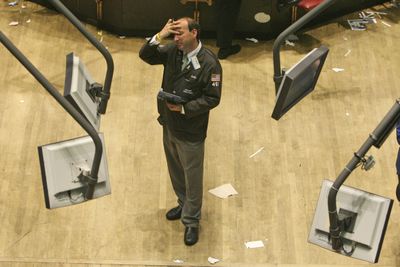Market watchers worry that rally may be peaking
Despite sell-off, however, economic signs still positive

CHICAGO – The stock market’s nose dive Monday abruptly ended the Dow’s foray into positive territory for 2009, leaving stock watchers to ponder whether an unexpectedly strong spring rally will survive into summer.
Plenty of evidence suggests the bull market may be done, or at least out of momentum, after 14 weeks on the upswing. The economy remains fragile, investors are increasingly worried about the prospect of rising interest rates, gas prices are climbing again, and a market correction was probably overdue.
The Dow Jones industrial average had rebounded 34 percent and the broader Standard & Poor’s 500 index 40 percent since sinking to 12-year lows on March 9. Such numbers made this the fastest-rising market after a bear-market bottom since the 1930s.
Yet despite Monday’s big downturn, it might be premature to bet against the market’s continuing comeback.
“People are underestimating the ability of the economy to pull itself out of this,” said Liz Ann Sonders, chief investment strategist for brokerage Charles Schwab & Co.
Skepticism about the rally’s staying power is nonetheless a good thing, she said. “If everyone were euphoric, I’d be more worried.”
Individual investors reflected that combination of hope and wariness Monday.
Gazing through the window at an electronic market board from outside an ETrade Financial outlet in downtown Chicago, 70-year-old Earl Youmans saw cause for optimism despite all the red numbers.
“I don’t think this is going to be the end of the rally,” said Youmans, of Aurora, Ill. “I think it’s just the beginning. All the money the government’s putting into the economy has got to do something.”
Nearby, 26-year-old software salesman Mike Schindler was more skeptical, saying he expects the market to move higher in the long term but isn’t sure about the months ahead.
“You have to get a lot more creative” to succeed in this market, he said. “You can’t just go pick random stocks on someone’s advice and expect to make money – you’ve got to do research on your own.”
The impetus behind the market’s rapid rise is multifaceted.
For starters, the banking and financial systems are no longer hemorrhaging as government support stanches the bleeding.
Also, stimulus spending has pumped money into the economy that has found its way to the stock market. According to New York-based Strategas Research Partners, the U.S. government has made plans to spend $11.4 trillion to stimulate the economy in the past two years and $2.4 trillion has been spent so far, most of it in the past year.
Investors, too, have found reassurance in some bad but not horrible economic data that show the recession winding down. The rate of job cuts has slowed, and consumer confidence, manufacturing activity, productivity measures and new and existing home sales all have increased recently, pointing to economic improvement.
Yet another reason the rally may have been so ferocious, according to Sonders: Money managers who were sitting on lots of investor cash felt pressured to pump it back into the market, facing not only performance risk but career risk if they stayed on the sidelines during the upswing after taking such big losses in 2008.
History appears to be on the side of current market bulls. In the four other markets since the Great Depression when the S&P fell 45 percent or more (the 2007-’09 decline was 57 percent), investors recovered two-thirds of their losses within two years and 100 percent in five years, notes Alan Skrainka, chief market strategist for St. Louis-based investment company Edward Jones.
On the bearish side, U.S. debt levels and the money supply are both rising fast, increasing the prospect of inflation.
Pessimistic market watchers also think that after the recent run-up, stocks are fairly valued, leaving little or no room for further climbs.